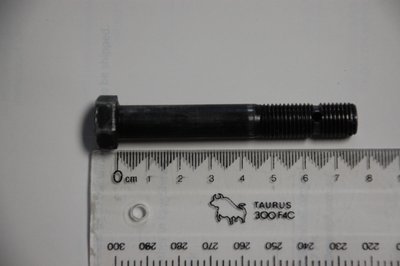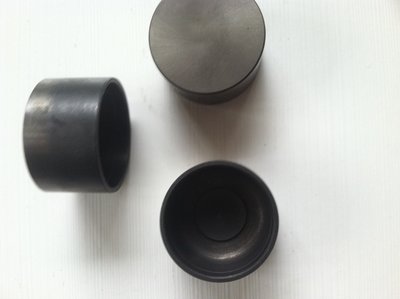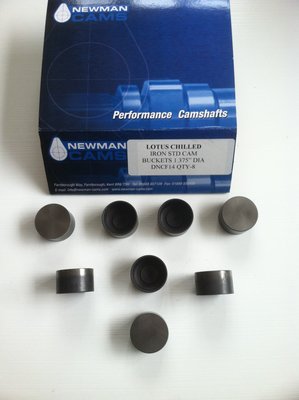Steel verses cast cam followers
47 posts
• Page 2 of 4 • 1, 2, 3, 4
It looks like the UHL could approach 60 mil back to the first oil feed hole and I figured that the existing bolts at around 30 mil UHL could be extended another 10 or 20 ( say 1 1/2") without any fuss in a steel cam motor for a bit of comfort/reassurance.
I'll have a look at the Cosworth arrangement over Chrissie & report back. (I think it still had it's original flimsy head gasket when Dad dis-assembled it, so whatever the set-up, it's probably ex factory).
Cheers
James
I'll have a look at the Cosworth arrangement over Chrissie & report back. (I think it still had it's original flimsy head gasket when Dad dis-assembled it, so whatever the set-up, it's probably ex factory).
Cheers
James
Last edited by SJ Lambert on Tue Dec 17, 2013 1:39 pm, edited 1 time in total.
Ford Escort Mk1 Lotus Twin Cam
Elfin Monocoque (Twin Cam)
Elfin Type 300 (Holbay S65 - 120E) mechanic
[email protected]
Elfin Monocoque (Twin Cam)
Elfin Type 300 (Holbay S65 - 120E) mechanic
[email protected]
-

SJ Lambert - Fourth Gear

- Posts: 681
- Joined: 19 Nov 2010
Is there any clarification of what a performance engine is when talking in terms of needing the long-bolt mod or not? IE what revs, cam lift or duration are the cut-off points?
A performance engine is a different thing to each man so it would be nice to get an idea of when to start looking to do the mod as these bolts aren't easily obtained and the re-drilling of cams to accept the bolt would need to be done with some accuracy so that the bolt clamps the sprocket wheel on squarely.
A performance engine is a different thing to each man so it would be nice to get an idea of when to start looking to do the mod as these bolts aren't easily obtained and the re-drilling of cams to accept the bolt would need to be done with some accuracy so that the bolt clamps the sprocket wheel on squarely.
-

promotor - Fourth Gear

- Posts: 797
- Joined: 16 Mar 2012
promotor wrote:Is there any clarification of what a performance engine is when talking in terms of needing the long-bolt mod or not? IE what revs, cam lift or duration are the cut-off points?
A performance engine is a different thing to each man so it would be nice to get an idea of when to start looking to do the mod as these bolts aren't easily obtained and the re-drilling of cams to accept the bolt would need to be done with some accuracy so that the bolt clamps the sprocket wheel on squarely.
Chain load on the cam is driven by a wide range of factors e.g. rpm, cam lift / acceleration, valve train mass and spring loads.
You don't need to do it for a standard road engine. You definitely should do it for a 8000 plus rpm full race motor running a high lift cast iron cam.
In between there is no hard and fast line.
If I was building a steel crank motor that would be run over 7000 rpm regularly I would do regardless of the cam profile choice. If I was building a standard bottom end engine but with a developed head with a high lift cam I may do depending on the cam and spring choice. I would probably not do with the QED420 cam and Q55 springs but I would probably do with a McCoy 450 cam and his springs as it imposes higher cam acceleration and spring loads
cheers
Rohan
-

rgh0 - Coveted Fifth Gear

- Posts: 8415
- Joined: 22 Sep 2003
Attached is a photo of the long cam bolt. The bolt is drilled with a 4mm oil passage up its centre and then side drilled to meet the hole in its centre and with the threads removed to line up with the cam oil hole in the first bearing so oil continues to be fed to the other cam bearings
The cam itself is drilled and tapped deeper to accommodate the longer bolt which reaches to the rear of the first bearing. The cam is also bored to remove the threads down to the start of the front of the first bearing so the bolt shank is a close fit down the cam to the threads.
The aim of this modification is that the bolt keeps the cast iron nose of the cam down to the first bearing in compression which reduces the bending tensile stress from the chain load which is the cause of it potentially breaking at the first bearing.
The bolt I have used is a standard carbon steel grade 5 high tensile bolt ( three lines on the head) which has proved sufficient.
cheers
Rohan
The cam itself is drilled and tapped deeper to accommodate the longer bolt which reaches to the rear of the first bearing. The cam is also bored to remove the threads down to the start of the front of the first bearing so the bolt shank is a close fit down the cam to the threads.
The aim of this modification is that the bolt keeps the cast iron nose of the cam down to the first bearing in compression which reduces the bending tensile stress from the chain load which is the cause of it potentially breaking at the first bearing.
The bolt I have used is a standard carbon steel grade 5 high tensile bolt ( three lines on the head) which has proved sufficient.
cheers
Rohan
-

rgh0 - Coveted Fifth Gear

- Posts: 8415
- Joined: 22 Sep 2003
rgh0 wrote:Hi James
...........
Surprised your Cosworth engine does not have it already but maybe it was retired from competition work before this mod came into vogue ?
cheers
Rohan
G'day Rohan
I've checked the Cosworth engine and it has standard short bolts. I reckon it hasn't turned a wheel in anger since 1970 give or take a year & probably has never been pulled down til now.
Thanks for the long bolt info.
Ford Escort Mk1 Lotus Twin Cam
Elfin Monocoque (Twin Cam)
Elfin Type 300 (Holbay S65 - 120E) mechanic
[email protected]
Elfin Monocoque (Twin Cam)
Elfin Type 300 (Holbay S65 - 120E) mechanic
[email protected]
-

SJ Lambert - Fourth Gear

- Posts: 681
- Joined: 19 Nov 2010
Without having done an exhaustive search, it would appear that any type of standard spec (OD) iron follower is as rare as hen's teeth.
I'm looking to instal a new set of followers into a high performance head that's lined for followers on one side, but runs straight into aluminium casting on the other. Cams are iron L1s, circa 1964.
I'm not sure whether, in an ideal world, it would be best to run iron followers, but if that's an academic question then I guess nitrided steel ones would be the way to go, but I ought to ensure that they don't have any coating aimed at use with steel cams?
I'm looking to instal a new set of followers into a high performance head that's lined for followers on one side, but runs straight into aluminium casting on the other. Cams are iron L1s, circa 1964.
I'm not sure whether, in an ideal world, it would be best to run iron followers, but if that's an academic question then I guess nitrided steel ones would be the way to go, but I ought to ensure that they don't have any coating aimed at use with steel cams?
Ford Escort Mk1 Lotus Twin Cam
Elfin Monocoque (Twin Cam)
Elfin Type 300 (Holbay S65 - 120E) mechanic
[email protected]
Elfin Monocoque (Twin Cam)
Elfin Type 300 (Holbay S65 - 120E) mechanic
[email protected]
-

SJ Lambert - Fourth Gear

- Posts: 681
- Joined: 19 Nov 2010
Nitrided steel followers run fine on cast iron cams. Its more a challenge to get steel followers to run well with steel cams.
Some steel followers come with a DLC ( diamond like carbon) coating aimed at assisting bedding in with steel cams. Clive at Clive Cams in Melbourne will also phosphate coat your new followers as an alternative which also assists bedding and I use when running steel followers
cheers
Rohan
Some steel followers come with a DLC ( diamond like carbon) coating aimed at assisting bedding in with steel cams. Clive at Clive Cams in Melbourne will also phosphate coat your new followers as an alternative which also assists bedding and I use when running steel followers
cheers
Rohan
-

rgh0 - Coveted Fifth Gear

- Posts: 8415
- Joined: 22 Sep 2003
Thanks for the advice fellas. Good to see that there are iron ones still available.
The tired ones I'm replacing are around .218/9" thick through the pad and are 1.3744" to 1.3745" in diameter.
I'm no dab hand with the spring/telescoping gauge, but I make the head sleeve bores to be 1.3752" to 1.3758".
My book has the bore in the head to be 1.3750 to 1.3755 but doesn't 't nominate a clearance or a tappet diameter.
I see Tony Ingram's listing a steel follower with .225" thickness and 1.3750" diameter.
Oughta be able to adjust existing top hats fairly easily with that pad thickness difference.
So the question is, should I go with steel or iron ?
The tired ones I'm replacing are around .218/9" thick through the pad and are 1.3744" to 1.3745" in diameter.
I'm no dab hand with the spring/telescoping gauge, but I make the head sleeve bores to be 1.3752" to 1.3758".
My book has the bore in the head to be 1.3750 to 1.3755 but doesn't 't nominate a clearance or a tappet diameter.
I see Tony Ingram's listing a steel follower with .225" thickness and 1.3750" diameter.
Oughta be able to adjust existing top hats fairly easily with that pad thickness difference.
So the question is, should I go with steel or iron ?
Ford Escort Mk1 Lotus Twin Cam
Elfin Monocoque (Twin Cam)
Elfin Type 300 (Holbay S65 - 120E) mechanic
[email protected]
Elfin Monocoque (Twin Cam)
Elfin Type 300 (Holbay S65 - 120E) mechanic
[email protected]
-

SJ Lambert - Fourth Gear

- Posts: 681
- Joined: 19 Nov 2010
Here's a link to a firm's DLH coatings to ponder as well!!!
http://www.richterprecision.com/dlc-coatings.html
Richters appear to be using a tetrahederal amorphous carbon coating on flat tappets that achieves a hardness of 5000-9000 HV
http://www.richterprecision.com/dlc-coatings.html
Richters appear to be using a tetrahederal amorphous carbon coating on flat tappets that achieves a hardness of 5000-9000 HV
Ford Escort Mk1 Lotus Twin Cam
Elfin Monocoque (Twin Cam)
Elfin Type 300 (Holbay S65 - 120E) mechanic
[email protected]
Elfin Monocoque (Twin Cam)
Elfin Type 300 (Holbay S65 - 120E) mechanic
[email protected]
-

SJ Lambert - Fourth Gear

- Posts: 681
- Joined: 19 Nov 2010
I see Arrow Precison offer followers with diamond like hardness coatings finished to .05 Ra, which seems pretty reasonable to me!
Ford Escort Mk1 Lotus Twin Cam
Elfin Monocoque (Twin Cam)
Elfin Type 300 (Holbay S65 - 120E) mechanic
[email protected]
Elfin Monocoque (Twin Cam)
Elfin Type 300 (Holbay S65 - 120E) mechanic
[email protected]
-

SJ Lambert - Fourth Gear

- Posts: 681
- Joined: 19 Nov 2010
I've spent a fair bit of time tossing this issue around because of what I've read here and also since I've already bought a par of steel QED420 camshafts, steel followers and racing springs for my engine - all from the same supplier. I contacted them expressing my concerns and they say they have never had any issues so touch wood I'm going to go forward with their advice rather than exchange the cams for chilled cast items which they also can supply. In fact for the 9XX series Lotus engine steel cam / steel followers is the only combination they supply. Their followers are all supplied phosphate coated by the way.
I guess it depends very much on the combination of properties of all the components together so my advice is to buy them all from the same supplier and go forward based on what they recommend. I very much hope I'm not proven wrong once this thing is all together however! Cast followers are heavy and I believe it's not unknown for them to crack in stressful applications.
Looking at various google pictures it seems that Ferrari is one of the few OEM's to run steel camshafts in flat tappet OHC application - not sure whether or not they run a special coating on the tappet. I guess it depends a lot on the production volume. Chilled cast being cheaper for high volume and machined steel for low volume.
I guess it depends very much on the combination of properties of all the components together so my advice is to buy them all from the same supplier and go forward based on what they recommend. I very much hope I'm not proven wrong once this thing is all together however! Cast followers are heavy and I believe it's not unknown for them to crack in stressful applications.
Looking at various google pictures it seems that Ferrari is one of the few OEM's to run steel camshafts in flat tappet OHC application - not sure whether or not they run a special coating on the tappet. I guess it depends a lot on the production volume. Chilled cast being cheaper for high volume and machined steel for low volume.
1970 Ford Escort Twin Cam
1972 Ford Escort GT1600 Twin Cam
1980 Ford Escort 2.0 Ghia
Peugeot 505 GTI Wagons (5spdx1) (Autox1)
2022 Ford Fiesta ST.
1972 Ford Escort GT1600 Twin Cam
1980 Ford Escort 2.0 Ghia
Peugeot 505 GTI Wagons (5spdx1) (Autox1)
2022 Ford Fiesta ST.
- 2cams70
- Coveted Fifth Gear

- Posts: 2166
- Joined: 10 Jun 2015
47 posts
• Page 2 of 4 • 1, 2, 3, 4
Total Online:
Users browsing this forum: No registered users and 34 guests




